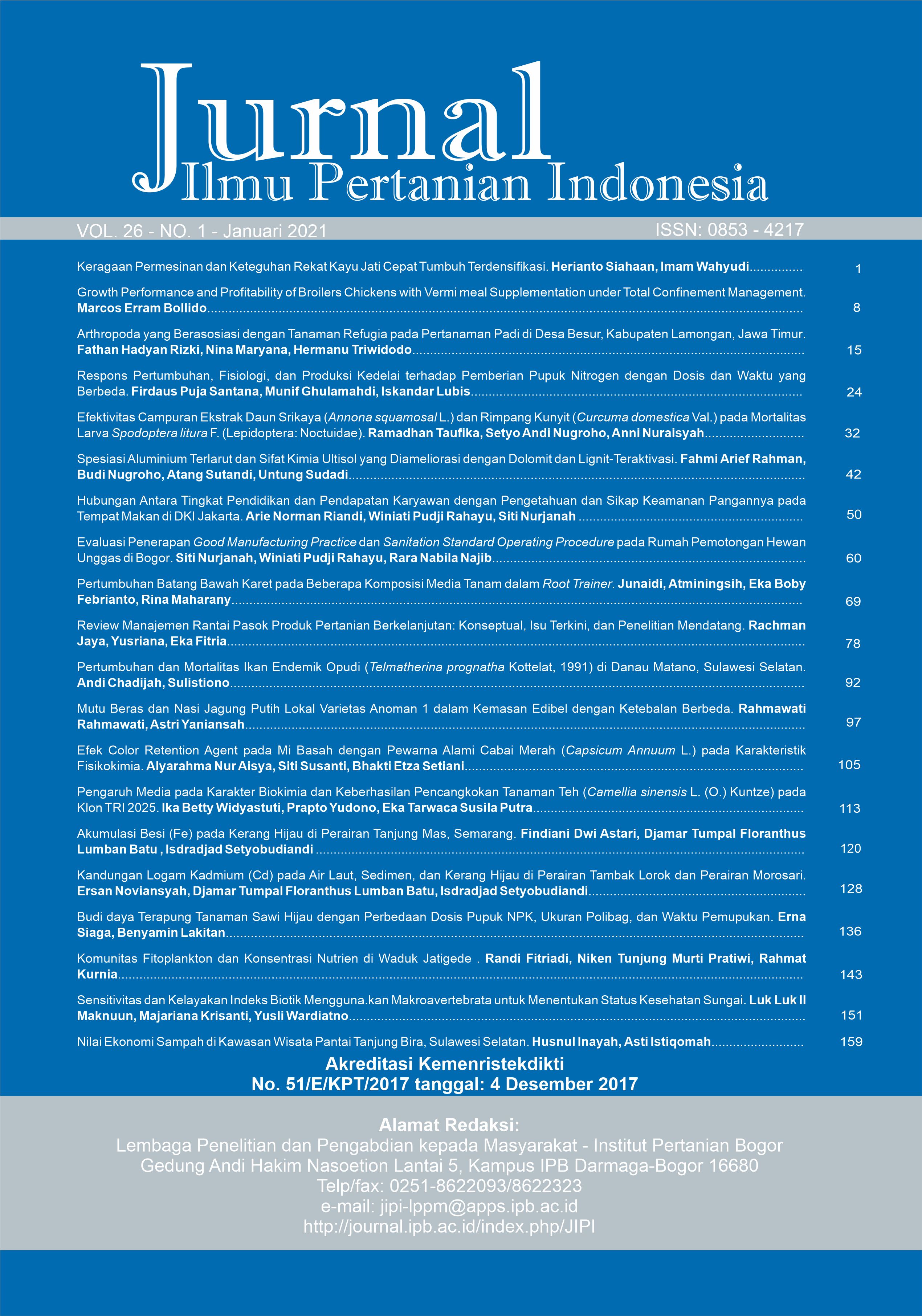Arthropoda yang Berasosiasi dengan Tanaman Refugia pada Pertanaman Padi di Desa Besur, Kabupaten Lamongan, Jawa Timur
Abstract
Rice farmers in Besur Village planted four species of refugia plants around rice plants to enhance biological control as a part of Healthy Plant Management Program. These refugia plants were flowering plants i.e., Cosmos sulphureus, Helianthus annuus, Zinnia elegans, and Sesamum indicum. The objective of this research was to observe the Arthropods associating with these refugia plants. This research was conducted in December 2017 to March 2018 at Besur Village, Lamongan District, East Java Province. Samples were obtained from each refugia species by branches beating, sweep net, pitfall trap, and direct observation method in the vegetative, generative, and postharvest periods paddy plant. The results showed that Arthropods associated with refugia plants are mostly belong to the order of Diptera, Hymenoptera, and Araneae. Detritivore group was the most abundant in all periods. Analysis of the diversity and similarity of all refugia species showed moderate to high values with high similarities each other.
Keywords: beneficial insect, flower, healthy plant management, integrated pest management, paddy field
Downloads
References
Abbas G, Arif MJ, Ashfaq M, Aslam M, Saeed S. 2010. Host plants, distribution and overwintering of cotton mealybug (Phenacoccus solenopsis; Hemiptera: Pseudococcidae). International Journal of Agriculture and Biology. 12: 421–425.
Balzan MV, Bocci G, Moonen AC. 2016. Utilisation of plant functional diversity in wildflower strips for the delivery of multiple agroecosystem services. Entomologia Experimentalis et Applicata. 158(3): 304–319. https://doi.org/10.1111/eea.12403
Barloggio G, Tamm L, Nagel P, Luka H. 2018. Selective flowers to attract and enhance Telenomus laeviceps (Hymenoptera: Scelionidae): a released biocontrol agent Mamestra brassicae (Lepidoptera: Noctuidae). Bulletin of Entomological Research. 109(2): 160–168. https://doi.org/10.1017/S0007 485318000287
Cook AG, Perfect TJ. 1989. Population dynamics of three leafhopper vectors of rice tungro viruses, Nephotettix virescens (Distant), N. nigropictus (Stål) and Recilia dorsalis (Motschulsky) (Hemiptera: Cicadellidae), in farmers' fields in the Philippines. Bulletin of Entomological Resesearch. 79(3): 437–451. https://doi.org/10.1017/S000748530 0018447
[CSIRO] Commonwealth Scientific and Industrial Research Organization. 2000. The Insect of Australia: A Textbook for Students and Research Workers. 1st Edition dan 2nd Edition. Victoria (AU): Melbourne Univ Press.
Changming GFC. 1989. Laboratory and filed studies on the predation of Nilaparvata lugens (Homoptera: Delphacidae) by Theridion octomaculatum (Araneae: Theridiidae). Chinese Journal of Biological Control. 5(2): 84–88.
Daniati C, Karindah S, Puspitarini, R. 2018. Three species of weeds enhance the population of predator and parasitoid of coffee berry borers. Biosaintifika. 10(1): 229–236. https://doi.org/ 10.15294/biosaintifika.v10i1.12076
[FAO] Food and Agriculture Organization. 2001. Glossary of biotechnology for food and agriculture – a revised and augmented edition of the glossary of biotechnology and genetic enginering [internet]. [diakses 17 September 2017]. Tersedia pada: http://www.fao.org/docrep/004/Y2775E/Y277 5E00.HTM
Jones WA. 1988. World review of the parasitoids of the southern green stink bug, Nezara viridula L. (Heteroptera: Pentatomidae). Annals of the Entomolgical Society of America. 81(2): 262–273. https://doi.org/10.1093/aesa/81.2.262
Kurniawati N, Martono E. 2015. Peran tumbuhan berbunga sebagai media konservasi Arthropoda dan musuh alami. Jurnal Perlindungan Tanaman Indonesia. 19(2): 53–59. https://doi.org/ 10.22146/jpti.16615
Leksono AS. 2017. Ekologi Arthropoda. Malang (ID): UB Press.
Levi HW, Levi LR, Zim HS. 1968. A Guide to Spiders and Their Kin. New York (US). Golden Press.
Lu ZX, Zhu PY, Gurr GM, Zheng XS, Read DMY, Heong KL, Yang YJ, Xu HX. 2014. Mechanisms for flowering plants to benefit arthropod natural enemis of insect pests: Prospects for enhanced use in agriculture. Insect Science. 21(1): 1–12. https://doi.org/10.1111/1744-7917.12000
Magurran AE. 2004. Measuring Biological Diversity Assesment. Victoria (AU). Blackwell.
O’Doherty DCO, Zoll JJK. 2012. Forcipomyia hardyi (Diptera: Ceratopogonidae), a potential pollinator of cacao (Theobroma cacao) flowers in Hawaii. Di dalam: Proceeding of Hawaiian Entomological Society [internet]. [waktu dan tempat pertemuan tidak diketahui]. Hawaii (US): Hawaiian Entomological Society. Hlm 79–81. [diunduh 2019 Nov 20]. Tersedia pada: https://scholar space.manoa.hawaii.edu /bitstream/10125/25464/ PHES-44_79-81.pdf
Oliver DR. 1981. Manual of Nearctic Diptera. Volume I. McAlpine JF, Peterson BV, Shewell GE, Teskey HJ, Vockerth JR, Wood DM, editor. Ottawa (CA): Research Branch Agriculture Canada.
Pfiffner L, Wyss E. 2004. Ecological Engineering for Pest Management: Advances in Habitat Manipulation for Arthorpods. Gurr GM, editor. Collingwood (AU): CSIRO.
Price MB, Young DK. 2006. An annotated checklist of Wisconsin sap and short-winged flower beetles (Coleoptera: Nitidulidae, Kateretidae). Insecta Mundi. 20(1): 69–84.
Starzomski BM, Suen D, Srivastava DS, 2010. Predation and facilitation determine chironomid emergence in a bromeliad‐insect food web. Ecological Entomology. 35(1): 53–60. https:// doi.org/10.1111/j.1365-2311.2009.01155.x
Rattanapun W. 2012. Biology and potentiality in biological control of Micraspis discolor (Fabricius) (Coleoptera: Coccinellidae). Communications in Agricultural and Applied Biological Science. 77(4): 541–548.
Suparni S, Putra NS, Suputa S. 2017. Population of herbivorous and carnivorous Arthropods in rice field ecosystem modified with vermicompost and flower plants. Jurnal Ilmu Pertanian. 2(2): 048–055. https://doi.org/10.22146/ipas.16983
Timesindonesia. 2017. Metode refugia sukses, Lamongan berniat perluasan lahan. [internet]. [diakses 10 September 2017]. Tersedia pada: https:// www.times indonesia.co.id/read/1424 28/20170214/141742/metode-refugia-sukses-lamongan-berniat-perluasan-lahan/.
Torres C, Galetto L. 2002. Are nectar sugar composition and corolla tube length related to the diversity of insect that visit Asteraceae flowers?. Plant Biology. 4(1): 360–366. https://doi.org/ 10.1055/s-2002-32326
Wahyuni R, Wijayanti R, Supriyadi. 2013. Peningkatan keragaman tumbuhan berbunga sebagai daya tarik predator hama padi. Journal of Agricultural Research. 2(5): 40–46.
Way MJ, Islam Z, Heong KL, Joshi RC. 1998. Ants in tropical irrigated rice: distribution and abundance, especially of Solenopsis geminata (Hymenoptera: Formicidae). Bulletin of Entomological Research. 88(1): 467–476. https://doi.org/10.1017/S000 7485300042218
Witriyanto R, Hadi M, Rahadian R. 2015. Keanekaragaman makroarthropoda tanah di lahan persawahan padi organik dan anorganik, Desa Bakalrejo Kecamatan Susukan Kabupaten Semarang. Bioma. 17(1): 21–26. https:// doi.org/10.14710/bioma.17.1.21-26
This journal is published under the terms of the Creative Commons Attribution-NonCommercial 4.0 International License. Authors who publish with this journal agree to the following terms: Authors retain copyright and grant the journal right of first publication with the work simultaneously licensed under a Creative Commons Attribution-NonCommercial 4.0 International License. Attribution — You must give appropriate credit, provide a link to the license, and indicate if changes were made. You may do so in any reasonable manner, but not in any way that suggests the licensor endorses you or your use. NonCommercial — You may not use the material for commercial purposes.























